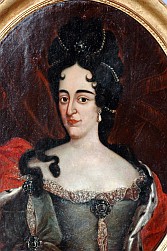Related Research Articles

Amalia of Solms-Braunfels was Princess of Orange by marriage to Frederick Henry, Prince of Orange. She acted as the political adviser of her spouse during his reign, and acted as his de facto deputy and regent during his infirmity from 1640 to 1647. She also served as chair of the regency council during the minority of her grandson William III, Prince of Orange from 1650 until 1672.

Princess Anna Amalia of Prussia was an early modern German composer and music curator who served as princess-abbess of Quedlinburg. She was a princess of Prussia as the daughter of Frederick William I of Prussia and the sister of Frederick the Great.

The County of Isenburg was a region of Germany located in southern present-day Hesse, located in territories north and south of Frankfurt. The states of Isenburg emerged from the Niederlahngau, which partitioned in 1137 into Isenburg-Isenburg and Isenburg-Limburg-Covern. These countships were partitioned between themselves many times over the next 700 years.

Archduchess Elisabeth Amalie of Austria was a daughter of Archduke Karl Ludwig of Austria and his third wife Infanta Maria Theresa of Portugal. She was the mother of Franz Joseph II, Prince of Liechtenstein, and the paternal grandmother of Hans-Adam II, Prince of Liechtenstein.

Thorn Abbey or the Imperial Abbey of Thorn was an imperial abbey of the Holy Roman Empire in what is now the Netherlands. The capital was Thorn. It was founded in the 10th century and remained independent until 1794, when it was occupied by French troops. The self-ruling abbey enjoyed imperial immediacy and belonged to the Lower Rhenish-Westphalian Circle.

Countess Maria Aurora von Königsmarck was a Swedish and German noblewoman of Brandenburg extraction and mistress of Augustus the Strong, Elector of Saxony and King of Poland.

Countess Maria Louise Albertine of Leiningen-Dagsburg-Falkenburg ; also known as Princess George, was heiress to the barony of Broich and by marriage Princess of Hesse-Darmstadt. She was the grandmother and educator of Princess Louise of Mecklenburg-Strelitz, who later became Queen consort of Prussia.
Amalia of Saxony was a princess of Saxony and by marriage Duchess of Bavaria-Landshut.

Margaret of Austria, a member of the House of Habsburg, was Electress consort of Saxony from 1431 until 1464 by her marriage with the Wettin elector Frederick II. She was a sister of Emperor Frederick III.
Margaret of Brandenburg was a princess of Brandenburg by birth and abbess of the Poor Clares monastery at Hof from 1476 to 1490.

Hedwig of Saxony was Princess-Abbess of Quedlinburg from 1458 until her death.

Duchess Anna Dorothea of Saxe-Weimar reigned as Princess-Abbess of Quedlinburg from 1684 until her death.

Duchess Marie Elisabeth of Schleswig-Holstein-Gottorp was Princess-Abbess of Quedlinburg from 1718 until her death.
Philipp II of Hanau-Lichtenberg ruled the County of Hanau-Lichtenberg from 1480 until his death.

Anna of Brandenburg was a Duchess consort of Mecklenburg.

Anna of Isenburg-Büdingen was a German noblewoman. She was a daughter of Count Louis II of Isenburg-Büdingen and Countess Maria of Nassau-Wiesbaden-Idstein.
Alix de Choiseul, also called Aleidis, was a German-Roman monarch as Princess Abbess of the Imperial Remiremont Abbey in France. She was abbess from 1507 until 1520. She resigned in favor of Madeleine de Choiseul shortly before her death.

Countess Mary of Nassau-Siegen, German: Maria Gräfin von Nassau-Siegen, official titles: Gräfin zu Nassau, Vianden und Diez, Frau zu Breda, was a countess from the House of Nassau-Siegen, a cadet branch of the Ottonian Line of the House of Nassau, and through marriage Countess of Nassau-Wiesbaden-Idstein.
References
- http://www.guide2womenleaders.com/womeninpower/Womeninpower1450.htm
- Nieuw Nederlandsch biografisch woordenboek. Deel 1(1911)–P.J. Blok, P.C. Molhuysen